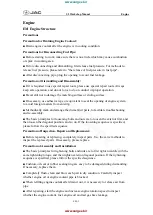
Vehicle care and maintenance
7-23
7
Treadwear, Traction and Temperature Grades
Treadwear
The treadwear grade is a comparative rating based on the wear
rate of the tire when tested under controlled conditions on a
specified government test course. For example, a tire graded
150 would wear one and one-half (1
1
/
2
) times as well on the
government course as a tire graded 100. The relative perfor-
mance of tires depends upon the actual conditions of their use,
however, and may depart significantly from the norm due to
variations in driving habits, service practices and differences in
road characteristics and climate.
Traction
The traction grades, from highest to lowest, are AA, A, B and
C. Those grades represent the tire’s ability to stop on wet pave-
ment as measured under controlled conditions on specified
government test surfaces of asphalt and concrete. A tire
marked C may have poor traction performance.
Temperature
The temperature grades are A (the highest), B and C, represent-
ing the tire’s resistance to the generation of heat and its ability
to dissipate heat when tested under controlled conditions on a
specified indoor laboratory test wheel. Sustained high tempera-
ture can cause the material of the tire to degenerate and reduce
tire life, and excessive temperature can lead to sudden tire fail-
ure. The grade C corresponds to a level of performance which
all passenger car tires must meet under the Federal Motor Vehi-
cle Safety Standard No. 109. Grades B and A represent higher
levels of performance on the laboratory test wheel than the
minimum required by law.
Tire inflation pressures
N00939300772
Proper tire inflation pressure is essential for the safe and satis-
factory operation of your vehicle. The wrong tire pressure will
cause problems in three major areas:
●
Safety
Too little pressure increases flexing in the tire and can
cause tire failure. Too much pressure can cause a tire to
lose its ability to cushion shock. Objects on the road and
potholes could then cause tire damage that may result in
tire failure.
●
Economy
The wrong tire pressure can cause uneven wear patterns in
the tire tread. These abnormal wear patterns will reduce
the tread life, and the tire will have to be replaced sooner.
Too little pressure also makes it harder for the tire to roll,
and this uses up more fuel.
●
Ride comfort and vehicle stability
The superior riding experience built into your vehicle
partly depends on the correct tire pressure. Too much
pressure gives an uncomfortable and jarring ride. Too lit-
tle pressure feels as if your vehicle is slow to respond.
Unequal tire pressures can make steering your vehicle
uneven and unpredictable.
The correct tire pressure for your vehicle is listed on the plac-
ard attached to the driver’s door sill.
(Refer to “Tire and loading information placard” on page 9-4.)
BK0115900US.book 23
ページ
2009年10月27日 火曜日 午後12時1分
Содержание ECLIPSE 2011
Страница 15: ...BK0115900US book 13 I n f o r ma t i o nP r o v i d e db y...
Страница 25: ...BK0115900US book 10 I n f o r ma t i o nP r o v i d e db y...
Страница 35: ...BK0115900US book 10 I n f o r ma t i o nP r o v i d e db y...
Страница 95: ...BK0115900US book 60 I n f o r ma t i o nP r o v i d e db y...
Страница 289: ...BK0115900US book 14 I n f o r ma t i o nP r o v i d e db y...
Страница 367: ...BK0115900US book 78 I n f o r ma t i o nP r o v i d e db y...
Страница 469: ...BK0115900US book 78 I n f o r ma t i o nP r o v i d e db y...
Страница 483: ...BK0115900US book 10 I n f o r ma t i o nP r o v i d e db y...
Страница 492: ...BK0115900US book 9 I n f o r ma t i o nP r o v i d e db y...
















































